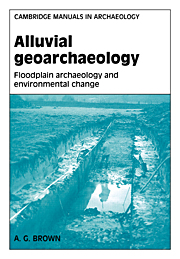Book contents
- Frontmatter
- Contents
- List of illustrations
- List of tables
- Preface
- Acknowledgements
- Introduction and the example of the Nile
- PART I PRINCIPLES
- 1 Floodplain evolution
- 2 Alluvial environments over time
- 3 Interpreting floodplain sediments and soils
- 4 Floodplain ecology, archaeobotany and archaeozoology
- PART II APPLICATION
- APPENDICES
- References
- Subject Index
- Index of rivers and sites
1 - Floodplain evolution
Published online by Cambridge University Press: 03 December 2009
- Frontmatter
- Contents
- List of illustrations
- List of tables
- Preface
- Acknowledgements
- Introduction and the example of the Nile
- PART I PRINCIPLES
- 1 Floodplain evolution
- 2 Alluvial environments over time
- 3 Interpreting floodplain sediments and soils
- 4 Floodplain ecology, archaeobotany and archaeozoology
- PART II APPLICATION
- APPENDICES
- References
- Subject Index
- Index of rivers and sites
Summary
Floodplains are one of the most conspicuous and widespread of all the landforms on the earth. They are the result of both erosional and depositional processes. Over time they develop and change and so they evolve, not to any end-point but to the form that they are today or were at any point in the past. The study of the processes and history of floodplain formation is in part a historical science (i.e. geology) and has much in common with scientific archaeology in both its history and methodology. An understanding of the fundamental processes and products of floodplain evolution is essential for the interpretation of sites in alluvial contexts and can yield fascinating insights into human–environment relationships.
Floodplain evolution: an introduction
Floodplains may be simply defined as the flat areas adjacent to rivers liable to flooding. Floodplains are also complex assemblages of landforms which, as shown in Figure 1.1, include: channel features such as bedforms (ripples and dunes) and bars (e.g. point-bars), channel-edge features such as banks, benches and levees, and floodplain features such as old channels (oxbows), old levees (scroll-bars), backswamps and crevasse-splays. The formation and character of these features will be covered later in this chapter. The existence, development and arrangement of such features is a record of the past history of the river and they may also subtly constrain the current activity of the river.
- Type
- Chapter
- Information
- Alluvial GeoarchaeologyFloodplain Archaeology and Environmental Change, pp. 17 - 44Publisher: Cambridge University PressPrint publication year: 1997



